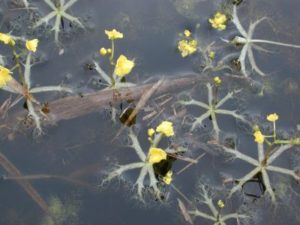
Utricularia spp.
More Info & Photos of Bladderwort
Non-Herbicide Management Options
1. Physical Management Options
Bladderwort can be removed by raking or seining it from the pond’s surface.
Fertilization to produce a phytoplankton or algal “bloom” prevents the establishment of most bottom rooted aquatic weeds and produces a strong food chain to the pond fish.
2. Biological Management Options
At this time, there are no biological control methods for Bladderwort.
Herbicide Control Options
Always read the product label for directions and precautions, as the label is the law. Click on the name of the product to see the label. Read the label for specific water use restrictions.
The active ingredients that have been successful in treating Bladderwort include:
- Diquat (Rated: Good)
- Fluridone (Rated: Good)
- Flumioxazin (Rated: Good)
- Penoxsulam (Rated: Good)
These ratings are based upon the U.S. Army Corps of Engineers aquatic herbicide trials.
1) Diquat:
Diquat is a contact algaecide and herbicide. Contact herbicides act quickly and kill all plant cells they come in contact with.
Common trade or product names include but are not limited to:
2) Fluridone:
Fluridone is a broad spectrum, systemic herbicide. Systemic herbicides are absorbed and move within the plant to the site of action. Systemic herbicides tend to act more slowly than contact herbicides.
Common trade and product names include but are not limited to:
3)Flumioxazin
Flumioxazin is a water dispensable granule that is to be sprayed or injected after mixing. It is a broad spectrum, contact herbicide. Contact herbicides act quickly. Flumioxazin should be applied to actively growing plants and a surfactant (a substance that reduces water tension) will be needed if the herbicide is applied to foliage of floating or emergent plants. Water pH needs to be below 8.5 or flumioxazin will rapidly degrade and lose effectiveness.
Common trade and product names include but are not limited to:
4) Penoxsulam
Penoxsulam is a broad spectrum, systemic herbicide. Systemic herbicides are absorbed and move within the plant to the site of action. Systemic herbicides tend to act more slowly than contact herbicides. It may be sprayed directly onto emergent plants or applied directly into the water. Penoxsulam should not be applied in areas where it will be diluted rapidly. This herbicide will need a registered surfactant (see the label) for leaf and exposed sediment applications.
Common trade and product names include but are not limited to:
Precautions
One danger with any chemical control method is the chance of an oxygen depletion after the treatment caused by the decomposition of the dead plant material. Oxygen depletion can kill fish in the pond. If the pond is heavily infested with weeds, it may be possible (depending on the herbicide chosen) to treat the pond in sections and let each section decompose for about two weeks before treating another section. Aeration, particularly at night, for several days after treatment may help control the oxygen depletion.
One common problem in using aquatic herbicides is determining area and/or volume of the pond or area to be treated. To assist you with these determinations see SRAC #103 Calculating Area and Volume of Ponds and Tanks.
Many aquatically registered herbicides have water use restrictions (See General Water Use Restrictions).
To see the labels for these products click on the name. Always read and follow all label directions. Check label for specific water use restrictions.
Cultivation Options
Bladderwort can be transferred as whole plants during the spring. They should be put in clear shallow areas of the pond.
Questions?
If you need assistance, contact the Ag & Natural Resources agent in your county or hire a professional.